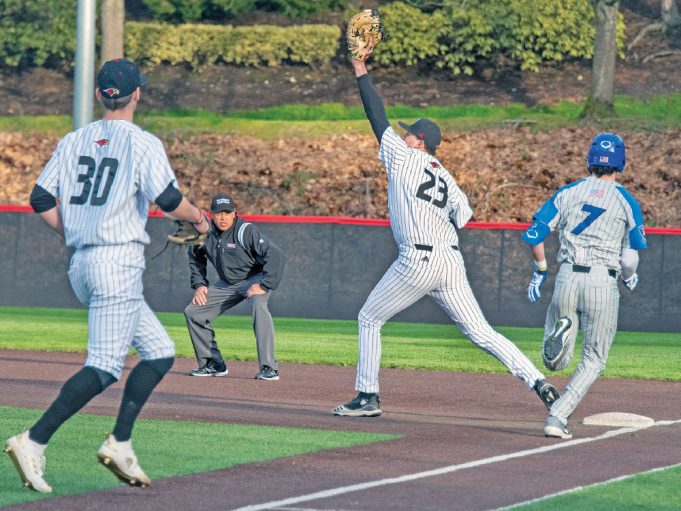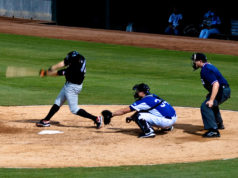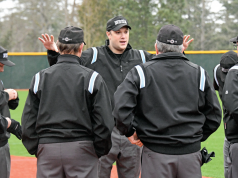If you’re new to umpiring (and maybe if you’re not), you might think rules should be enforced literally, no matter the circumstances. After all, if rulesmakers thought it was important enough to enact a rule, why would they want us to have the discretion to ignore it? Admittedly, there’s logic in this notion. I submit, however, being a “Rulebook Charlie” — a by-the-book enforcer — will negatively affect your games and may derail your career. It’s better to try to divine the intent behind rules and to enforce them accordingly. Put another way, use the advantage-disadvantage philosophy, which tells us to use the rules as tools to keep one team from gaining an unfair advantage over the other one.
Purists may not like this approach, but it has been widely accepted since the days of Abner Doubleday. It best conforms to participants’ and observers’ desires and expectations, and it works best in terms of keeping games running smoothly.
Sometimes a rule is clear, but applying it in certain situations would serve no valid purpose and disrupt the game’s flow. Say, with a runner on base, the pitcher toes the rubber with his hands together, separates them, and looks in for the catcher’s sign. Technically this is a balk, but we often don’t call it because no one has been hurt. Neither the batter nor the runner will shift into high-alert gear until the pitcher addresses the batter, so to call a balk before then is nitpicky.
A batter hits an infield grounder and the ball beats him to first base by two steps. Knowing it’s a nothing play, the first baseman pulls his foot off the bag just before the throw hits his glove. By rule the runner is safe, but to call it that way could start a riot. Different story if it’s a bang-bang play or the throw is off-target and he has to stretch for it because now his foot leaving the bag early could make a difference.
Assuming an accurate throw, we generally don’t quibble if a middle infielder isn’t quite on the bag when the throw arrives on the front end of a double play (the “neighborhood play”). The advent of instant replay has put a crimp in enforcing these time-honored rules of thumb, but most umpires don’t work games with replay.
Focusing on the intent of rules also helps if their words are confusing or it’s unclear how they should apply in a given situation. It’s tough writing rules and sometimes drafters don’t get it exactly right.
In the early ’90s I was involved in writing the NCAA collision rule, which says if a fielder has the ball and a runner crashes into him to dislodge it, the runner is out and ejected if the collision is flagrant. The rules editor and I spent hours trying to craft a rule that reflected the rules committee’s intent and umpires could understand. But it quickly became clear the language we chose didn’t address a lot of questions. Facing a situation we hadn’t thought of, some umpires applied the rule literally although it led to absurd results like calling a runner out for contacting a catcher racing 10 feet up the third-base line because that’s where the throw took him. But most tried to understand what we had sought to accomplish in creating the rule, enforced it accordingly and avoided such results.
That’s the approach I advocate in these situations. Then, hope for guidance from the powers-that-be and that our issues are addressed in future rulesmaking cycles, as was the case with the collision rule.
How we apply rules should also take the level of ball into account. For example, what warrants a balk call at the college or even high school level may justifiably be ignored, or result in a between-inning talk-to, in “kid ball.” Also, there’s a difference between ordinary rules and those relating to player safety, which should be enforced to the letter.
If this sounds complex, it is. Learning how and when to apply rules in terms of their spirit doesn’t happen overnight. You may have an edge if you played ball before you started umpiring because you may have a sense of how things work in actuality rather than on paper, but there’s still no substitute for on-the-job learning.
Can the maturation process be sped up? Yes. Early in my umpiring career I latched on to some old-heads in my chapter. Whether I worked with them or just accompanied them to local watering holes, I picked their brains in terms of what to call and to ignore. They were mentors, and what I learned hastened my advancement.
Find mentors. If you work with a seasoned umpire, especially one with a good reputation, ask questions about everything you can think of. Most will be willing, even eager, to help out, but many won’t do so unless asked. And then don’t be the “yes, but” type who always has an excuse for what he or she did. Listen to what they say; some of it will be useful and some won’t, but give it a chance. There’s also a ton of do’s-and-don’ts training material available today; use it.
To wrap up, when I was a tyke umpiring-wise I heard veterans say “use common sense” in applying rules. I didn’t find this helpful because it begs the question of what common sense means. But eventually I saw this was a way of saying we shouldn’t get so bogged down in words that we lose sight of their intent. This approach will keep us from being too technical and make us more adept at handling cases where the wording is unclear or doesn’t quite fit a situation that arises. The result will likely be better games and careers.
What's Your Call? Leave a Comment:
Note: This article is archival in nature. Rules, interpretations, mechanics, philosophies and other information may or may not be correct for the current year.
This article is the copyright of ©Referee Enterprises, Inc., and may not be republished in whole or in part online, in print or in any capacity without expressed written permission from Referee. The article is made available for educational use by individuals.


















